VOLVO XC90 2014 Owner´s Manual
Manufacturer: VOLVO, Model Year: 2014, Model line: XC90, Model: VOLVO XC90 2014Pages: 308, PDF Size: 13.31 MB
Page 31 of 308
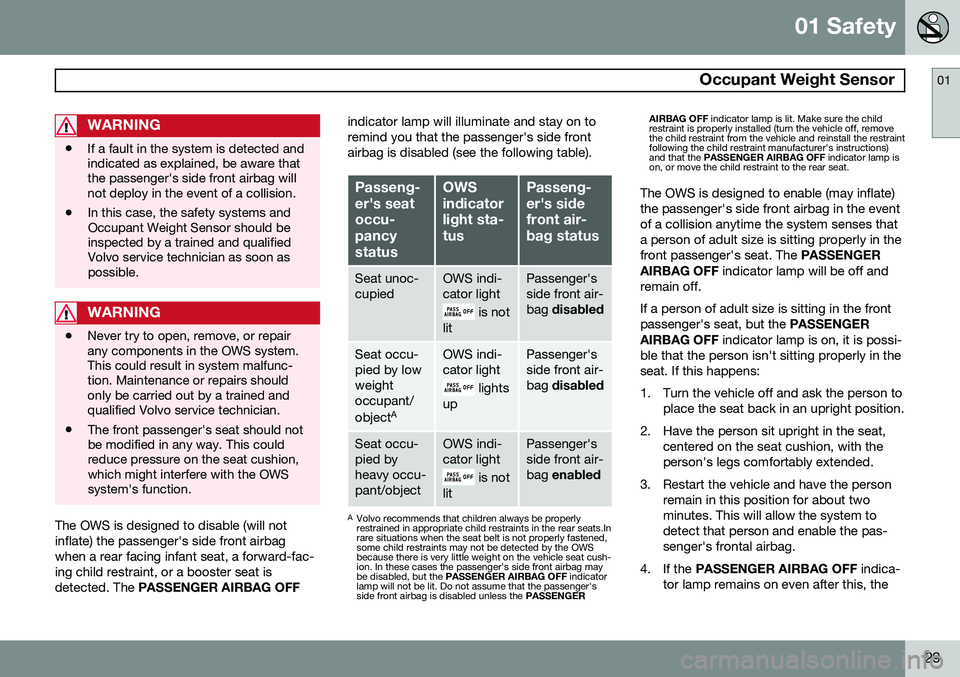
01 Safety
Occupant Weight Sensor01
29
WARNING
•If a fault in the system is detected and indicated as explained, be aware thatthe passenger's side front airbag willnot deploy in the event of a collision.
• In this case, the safety systems andOccupant Weight Sensor should beinspected by a trained and qualifiedVolvo service technician as soon aspossible.
WARNING
•Never try to open, remove, or repair any components in the OWS system.This could result in system malfunc-tion. Maintenance or repairs shouldonly be carried out by a trained andqualified Volvo service technician.
• The front passenger's seat should notbe modified in any way. This couldreduce pressure on the seat cushion,which might interfere with the OWSsystem's function.
The OWS is designed to disable (will not inflate) the passenger's side front airbagwhen a rear facing infant seat, a forward-fac-ing child restraint, or a booster seat isdetected. The
PASSENGER AIRBAG OFF indicator lamp will illuminate and stay on toremind you that the passenger's side frontairbag is disabled (see the following table).
Passeng- er's seatoccu-pancystatusOWS indicatorlight sta-tusPasseng- er's sidefront air-bag status
Seat unoc- cupiedOWS indi- cator light
is not
lit
Passenger's side front air-bag disabled
Seat occu- pied by lowweightoccupant/ object AOWS indi- cator light
lights
up
Passenger's side front air-bag disabled
Seat occu- pied byheavy occu-pant/objectOWS indi- cator light
is not
lit
Passenger's side front air-bag enabled
A
Volvo recommends that children always be properly restrained in appropriate child restraints in the rear seats.Inrare situations when the seat belt is not properly fastened,some child restraints may not be detected by the OWSbecause there is very little weight on the vehicle seat cush-ion. In these cases the passenger's side front airbag maybe disabled, but the PASSENGER AIRBAG OFF indicator
lamp will not be lit. Do not assume that the passenger'sside front airbag is disabled unless the PASSENGERAIRBAG OFF
indicator lamp is lit. Make sure the child
restraint is properly installed (turn the vehicle off, removethe child restraint from the vehicle and reinstall the restraintfollowing the child restraint manufacturer's instructions)and that the PASSENGER AIRBAG OFF indicator lamp is
on, or move the child restraint to the rear seat.
The OWS is designed to enable (may inflate) the passenger's side front airbag in the eventof a collision anytime the system senses thata person of adult size is sitting properly in thefront passenger's seat. The PASSENGER
AIRBAG OFF indicator lamp will be off and
remain off. If a person of adult size is sitting in the front passenger's seat, but the PASSENGER
AIRBAG OFF indicator lamp is on, it is possi-
ble that the person isn't sitting properly in theseat. If this happens:
1. Turn the vehicle off and ask the person to place the seat back in an upright position.
2. Have the person sit upright in the seat, centered on the seat cushion, with the person's legs comfortably extended.
3. Restart the vehicle and have the person remain in this position for about twominutes. This will allow the system todetect that person and enable the pas-senger's frontal airbag.
4. If the PASSENGER AIRBAG OFF indica-
tor lamp remains on even after this, the
Page 32 of 308
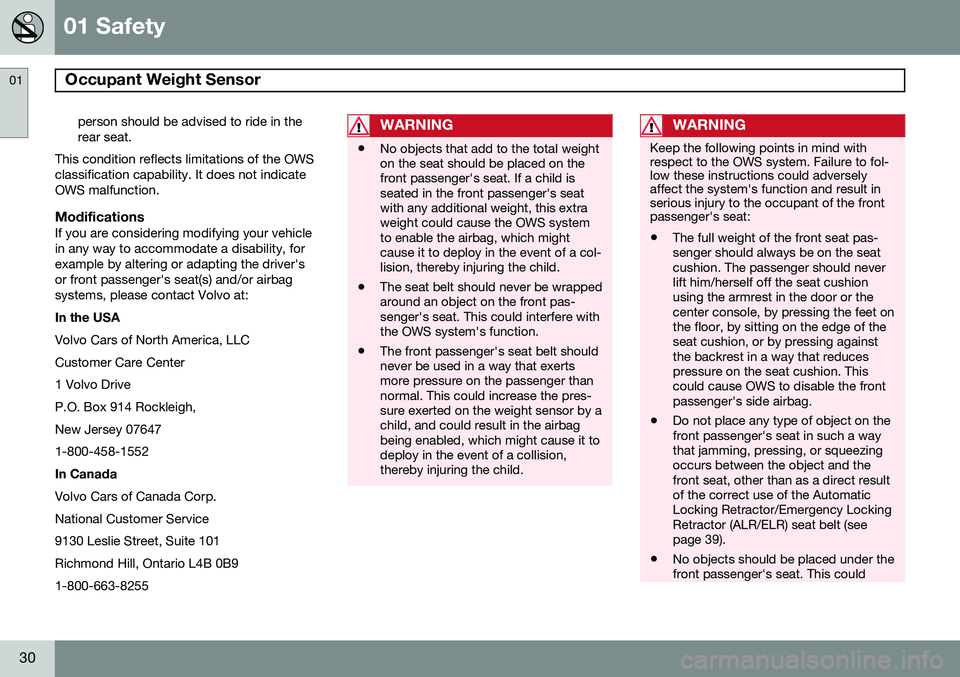
01 Safety
Occupant Weight Sensor 01
30
person should be advised to ride in the rear seat.
This condition reflects limitations of the OWSclassification capability. It does not indicateOWS malfunction.
ModificationsIf you are considering modifying your vehiclein any way to accommodate a disability, forexample by altering or adapting the driver'sor front passenger's seat(s) and/or airbagsystems, please contact Volvo at: In the USA Volvo Cars of North America, LLC Customer Care Center1 Volvo DriveP.O. Box 914 Rockleigh,New Jersey 076471-800-458-1552 In Canada Volvo Cars of Canada Corp. National Customer Service9130 Leslie Street, Suite 101Richmond Hill, Ontario L4B 0B91-800-663-8255
WARNING
• No objects that add to the total weight on the seat should be placed on thefront passenger's seat. If a child isseated in the front passenger's seatwith any additional weight, this extraweight could cause the OWS systemto enable the airbag, which mightcause it to deploy in the event of a col-lision, thereby injuring the child.
• The seat belt should never be wrappedaround an object on the front pas-senger's seat. This could interfere withthe OWS system's function.
• The front passenger's seat belt shouldnever be used in a way that exertsmore pressure on the passenger thannormal. This could increase the pres-sure exerted on the weight sensor by achild, and could result in the airbagbeing enabled, which might cause it todeploy in the event of a collision,thereby injuring the child.
WARNING
Keep the following points in mind with respect to the OWS system. Failure to fol-low these instructions could adverselyaffect the system's function and result inserious injury to the occupant of the frontpassenger's seat:
• The full weight of the front seat pas- senger should always be on the seatcushion. The passenger should neverlift him/herself off the seat cushionusing the armrest in the door or thecenter console, by pressing the feet onthe floor, by sitting on the edge of theseat cushion, or by pressing againstthe backrest in a way that reducespressure on the seat cushion. Thiscould cause OWS to disable the frontpassenger's side airbag.
• Do not place any type of object on thefront passenger's seat in such a waythat jamming, pressing, or squeezingoccurs between the object and thefront seat, other than as a direct resultof the correct use of the AutomaticLocking Retractor/Emergency LockingRetractor (ALR/ELR) seat belt (seepage 39).
• No objects should be placed under thefront passenger's seat. This could
Page 33 of 308
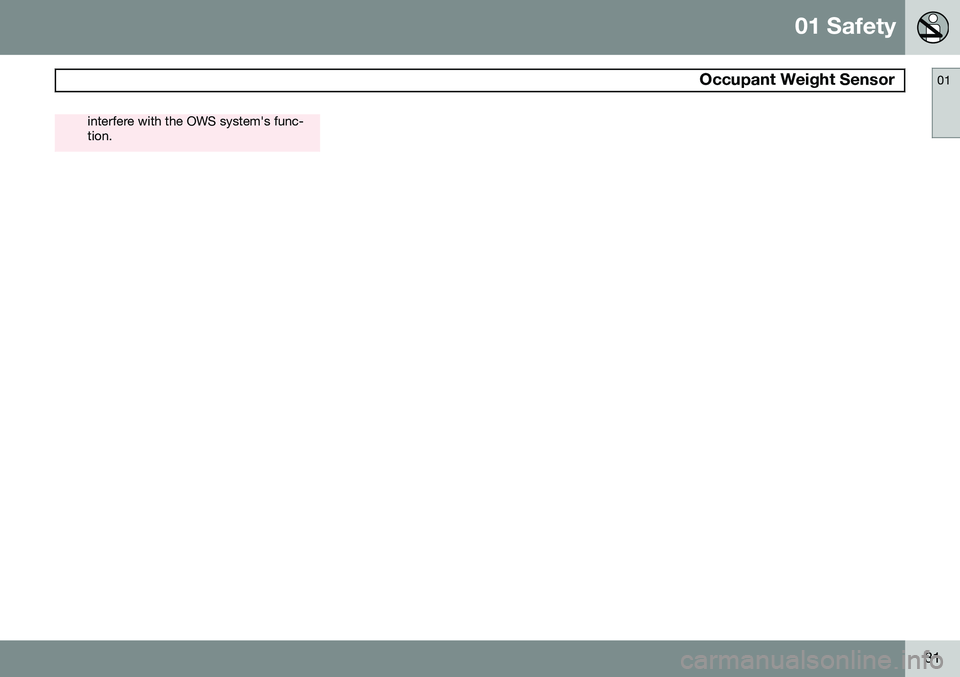
01 Safety
Occupant Weight Sensor01
31
interfere with the OWS system's func- tion.
Page 34 of 308
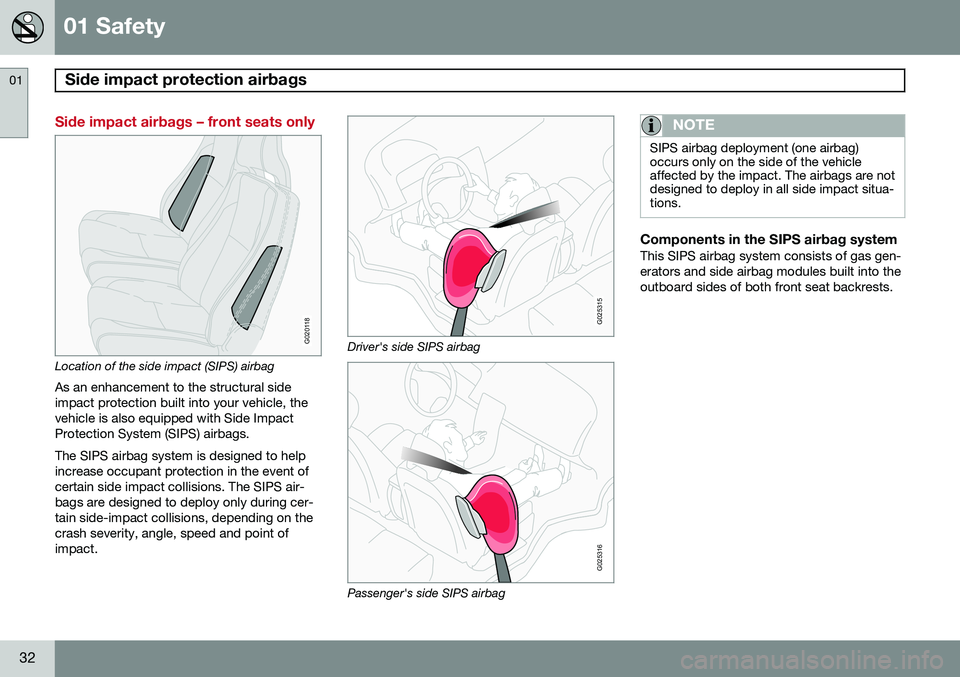
01 Safety
Side impact protection airbags 01
32
Side impact airbags – front seats only
G020118
Location of the side impact (SIPS) airbag
As an enhancement to the structural side impact protection built into your vehicle, thevehicle is also equipped with Side ImpactProtection System (SIPS) airbags. The SIPS airbag system is designed to help increase occupant protection in the event ofcertain side impact collisions. The SIPS air-bags are designed to deploy only during cer-tain side-impact collisions, depending on thecrash severity, angle, speed and point ofimpact.
G025315
Driver's side SIPS airbag
G025316
Passenger's side SIPS airbag
NOTE
SIPS airbag deployment (one airbag) occurs only on the side of the vehicleaffected by the impact. The airbags are notdesigned to deploy in all side impact situa-tions.
Components in the SIPS airbag systemThis SIPS airbag system consists of gas gen- erators and side airbag modules built into theoutboard sides of both front seat backrests.
Page 35 of 308
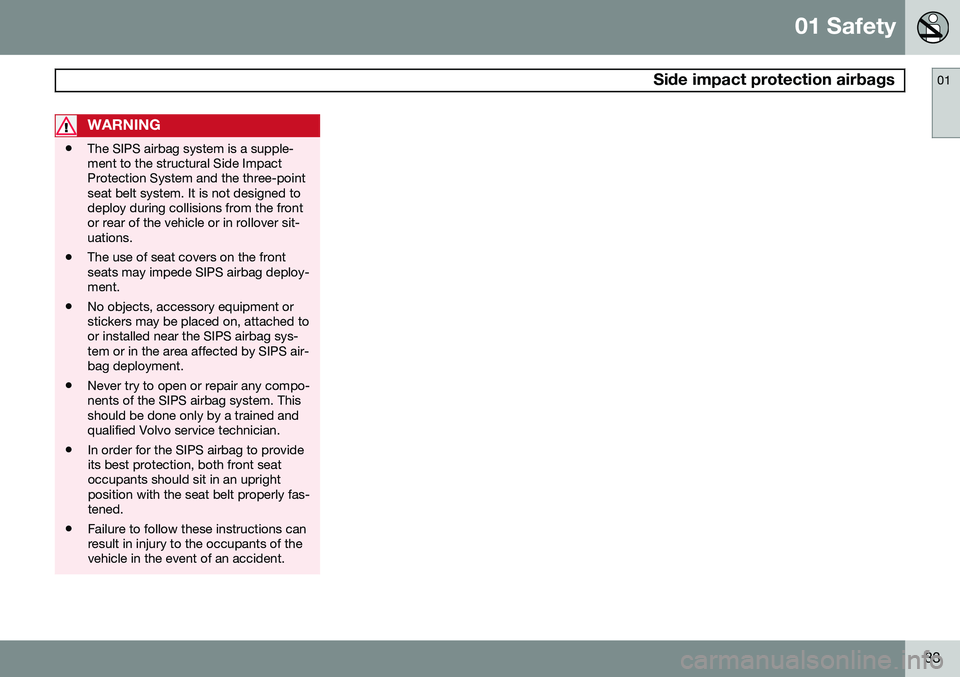
01 Safety
Side impact protection airbags01
33
WARNING
•The SIPS airbag system is a supple- ment to the structural Side ImpactProtection System and the three-pointseat belt system. It is not designed todeploy during collisions from the frontor rear of the vehicle or in rollover sit-uations.
• The use of seat covers on the frontseats may impede SIPS airbag deploy-ment.
• No objects, accessory equipment orstickers may be placed on, attached toor installed near the SIPS airbag sys-tem or in the area affected by SIPS air-bag deployment.
• Never try to open or repair any compo-nents of the SIPS airbag system. Thisshould be done only by a trained andqualified Volvo service technician.
• In order for the SIPS airbag to provideits best protection, both front seatoccupants should sit in an uprightposition with the seat belt properly fas-tened.
• Failure to follow these instructions canresult in injury to the occupants of thevehicle in the event of an accident.
Page 36 of 308
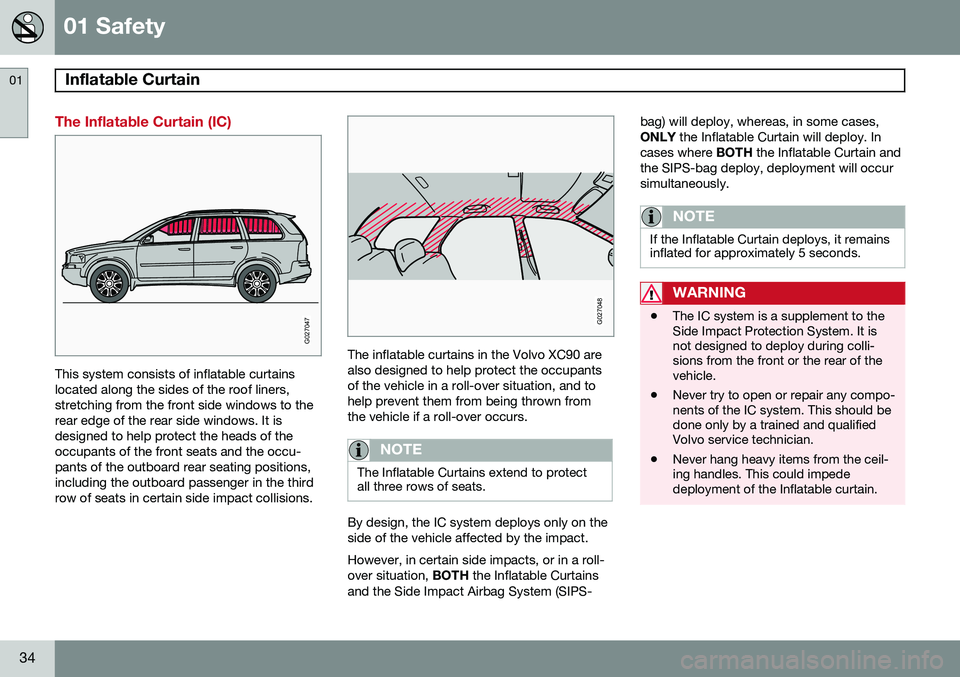
01 Safety
Inflatable Curtain 01
34
The Inflatable Curtain (IC)
G027047
This system consists of inflatable curtains located along the sides of the roof liners,stretching from the front side windows to therear edge of the rear side windows. It isdesigned to help protect the heads of theoccupants of the front seats and the occu-pants of the outboard rear seating positions,including the outboard passenger in the thirdrow of seats in certain side impact collisions.
G027048
The inflatable curtains in the Volvo XC90 are also designed to help protect the occupantsof the vehicle in a roll-over situation, and tohelp prevent them from being thrown fromthe vehicle if a roll-over occurs.
NOTE
The Inflatable Curtains extend to protect all three rows of seats.
By design, the IC system deploys only on the side of the vehicle affected by the impact. However, in certain side impacts, or in a roll- over situation, BOTH the Inflatable Curtains
and the Side Impact Airbag System (SIPS- bag) will deploy, whereas, in some cases,ONLY
the Inflatable Curtain will deploy. In
cases where BOTH the Inflatable Curtain and
the SIPS-bag deploy, deployment will occursimultaneously.
NOTE
If the Inflatable Curtain deploys, it remains inflated for approximately 5 seconds.
WARNING
• The IC system is a supplement to the Side Impact Protection System. It isnot designed to deploy during colli-sions from the front or the rear of thevehicle.
• Never try to open or repair any compo-nents of the IC system. This should bedone only by a trained and qualifiedVolvo service technician.
• Never hang heavy items from the ceil-ing handles. This could impededeployment of the Inflatable curtain.
Page 37 of 308
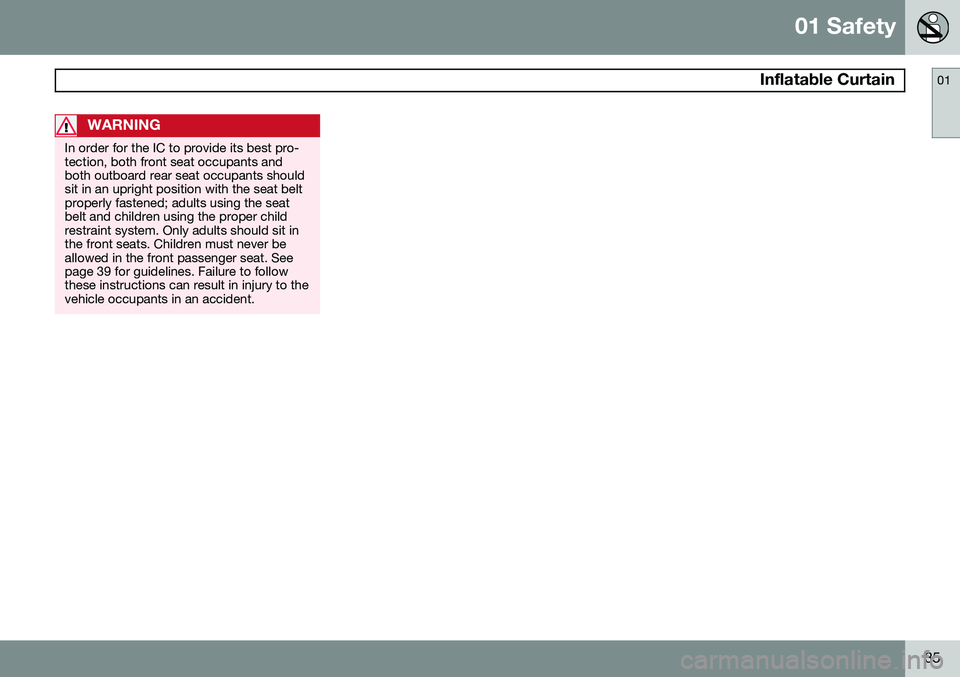
01 Safety
Inflatable Curtain01
35
WARNING
In order for the IC to provide its best pro- tection, both front seat occupants andboth outboard rear seat occupants shouldsit in an upright position with the seat beltproperly fastened; adults using the seatbelt and children using the proper childrestraint system. Only adults should sit inthe front seats. Children must never beallowed in the front passenger seat. Seepage 39 for guidelines. Failure to followthese instructions can result in injury to thevehicle occupants in an accident.
Page 38 of 308
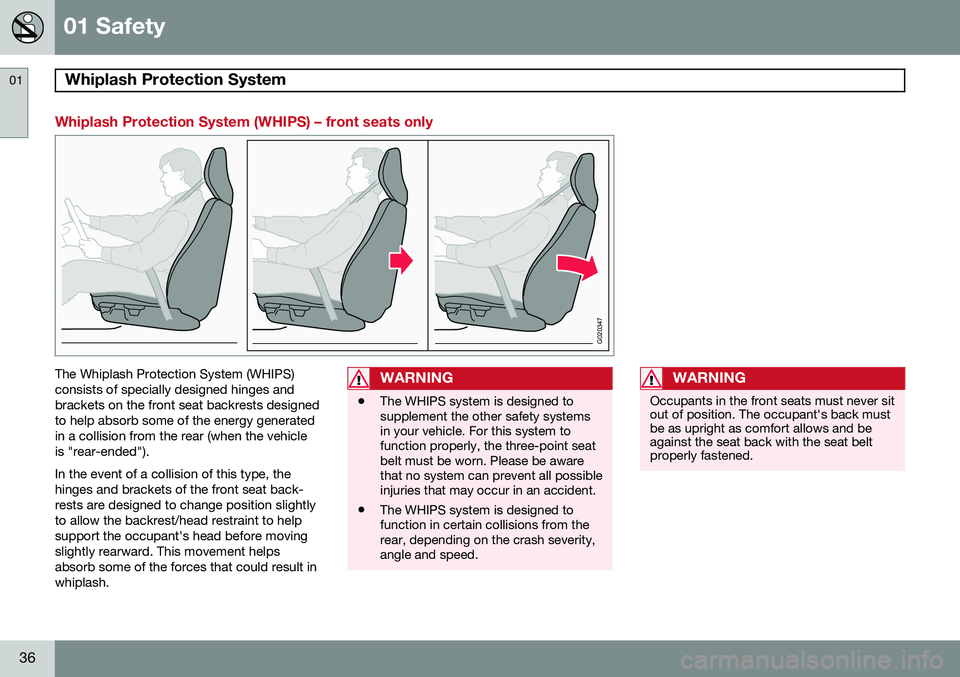
01 Safety
Whiplash Protection System 01
36
Whiplash Protection System (WHIPS) – front seats only
G020347
The Whiplash Protection System (WHIPS) consists of specially designed hinges andbrackets on the front seat backrests designedto help absorb some of the energy generatedin a collision from the rear (when the vehicleis "rear-ended"). In the event of a collision of this type, the hinges and brackets of the front seat back-rests are designed to change position slightlyto allow the backrest/head restraint to helpsupport the occupant's head before movingslightly rearward. This movement helpsabsorb some of the forces that could result inwhiplash.WARNING
•The WHIPS system is designed to supplement the other safety systemsin your vehicle. For this system tofunction properly, the three-point seatbelt must be worn. Please be awarethat no system can prevent all possibleinjuries that may occur in an accident.
• The WHIPS system is designed tofunction in certain collisions from therear, depending on the crash severity,angle and speed.
WARNING
Occupants in the front seats must never sit out of position. The occupant's back mustbe as upright as comfort allows and beagainst the seat back with the seat beltproperly fastened.
Page 39 of 308
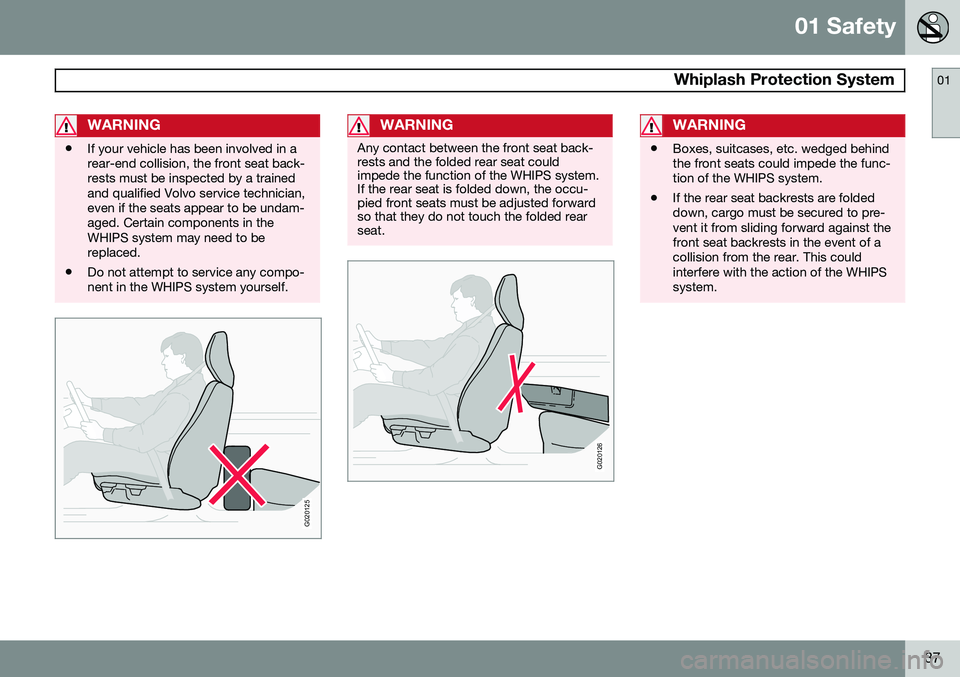
01 Safety
Whiplash Protection System01
37
WARNING
•If your vehicle has been involved in a rear-end collision, the front seat back-rests must be inspected by a trainedand qualified Volvo service technician,even if the seats appear to be undam-aged. Certain components in theWHIPS system may need to bereplaced.
• Do not attempt to service any compo-nent in the WHIPS system yourself.
G020125
WARNING
Any contact between the front seat back- rests and the folded rear seat couldimpede the function of the WHIPS system.If the rear seat is folded down, the occu-pied front seats must be adjusted forwardso that they do not touch the folded rearseat.
G020126
WARNING
•Boxes, suitcases, etc. wedged behind the front seats could impede the func-tion of the WHIPS system.
• If the rear seat backrests are foldeddown, cargo must be secured to pre-vent it from sliding forward against thefront seat backrests in the event of acollision from the rear. This couldinterfere with the action of the WHIPSsystem.
Page 40 of 308
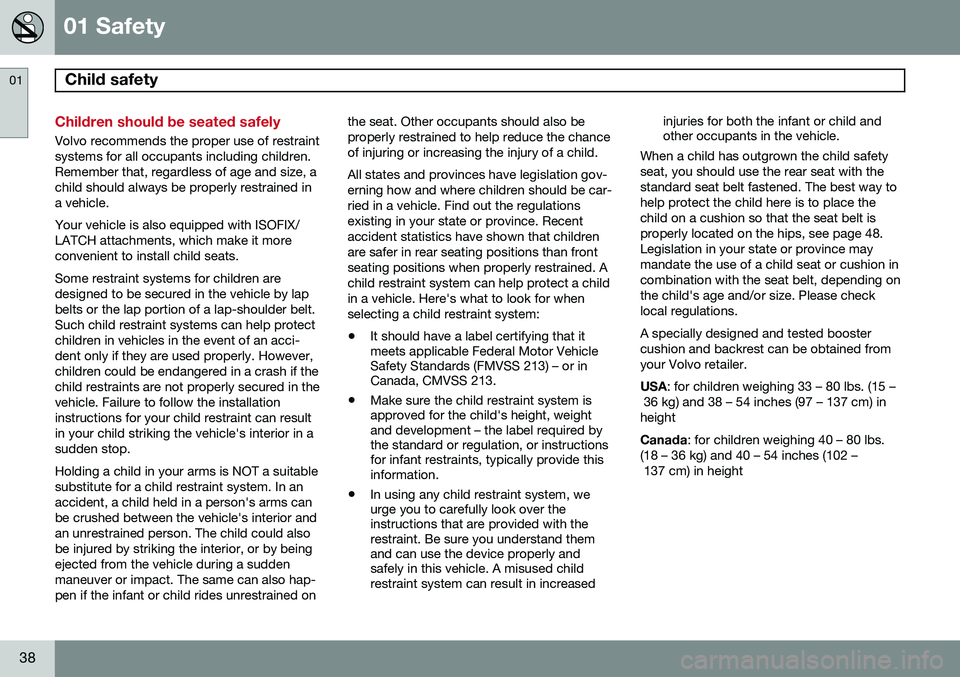
01 Safety
Child safety 01
38
Children should be seated safely
Volvo recommends the proper use of restraint systems for all occupants including children.Remember that, regardless of age and size, achild should always be properly restrained ina vehicle. Your vehicle is also equipped with ISOFIX/ LATCH attachments, which make it moreconvenient to install child seats. Some restraint systems for children are designed to be secured in the vehicle by lapbelts or the lap portion of a lap-shoulder belt.Such child restraint systems can help protectchildren in vehicles in the event of an acci-dent only if they are used properly. However,children could be endangered in a crash if thechild restraints are not properly secured in thevehicle. Failure to follow the installationinstructions for your child restraint can resultin your child striking the vehicle's interior in asudden stop. Holding a child in your arms is NOT a suitable substitute for a child restraint system. In anaccident, a child held in a person's arms canbe crushed between the vehicle's interior andan unrestrained person. The child could alsobe injured by striking the interior, or by beingejected from the vehicle during a suddenmaneuver or impact. The same can also hap-pen if the infant or child rides unrestrained onthe seat. Other occupants should also beproperly restrained to help reduce the chanceof injuring or increasing the injury of a child. All states and provinces have legislation gov- erning how and where children should be car-ried in a vehicle. Find out the regulationsexisting in your state or province. Recentaccident statistics have shown that childrenare safer in rear seating positions than frontseating positions when properly restrained. Achild restraint system can help protect a childin a vehicle. Here's what to look for whenselecting a child restraint system: •
It should have a label certifying that it meets applicable Federal Motor VehicleSafety Standards (FMVSS 213) – or inCanada, CMVSS 213.
• Make sure the child restraint system isapproved for the child's height, weightand development – the label required bythe standard or regulation, or instructionsfor infant restraints, typically provide thisinformation.
• In using any child restraint system, weurge you to carefully look over theinstructions that are provided with therestraint. Be sure you understand themand can use the device properly andsafely in this vehicle. A misused childrestraint system can result in increased injuries for both the infant or child andother occupants in the vehicle.
When a child has outgrown the child safety seat, you should use the rear seat with thestandard seat belt fastened. The best way tohelp protect the child here is to place thechild on a cushion so that the seat belt isproperly located on the hips, see page 48.Legislation in your state or province maymandate the use of a child seat or cushion incombination with the seat belt, depending onthe child's age and/or size. Please checklocal regulations. A specially designed and tested booster cushion and backrest can be obtained fromyour Volvo retailer. USA : for children weighing 33 – 80 lbs. (15 –
36 kg) and 38 – 54 inches (97 – 137 cm) in height Canada : for children weighing 40 – 80 lbs.
(18 – 36 kg) and 40 – 54 inches (102 – 137 cm) in height